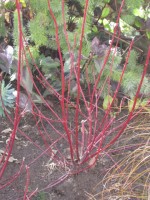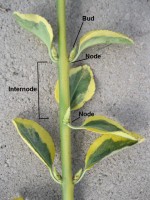 Plant stems are an important part of any garden. They vary in size, shape, color, and texture all of which add to the beauty of the garden. Stems may be fleshy or woody and used for propagation, to serve as food for wildlife and man, or to build a large variety of goods. Our gardens and lives would be very different without stems so let’s take a look what they’re about.
Plant stems are an important part of any garden. They vary in size, shape, color, and texture all of which add to the beauty of the garden. Stems may be fleshy or woody and used for propagation, to serve as food for wildlife and man, or to build a large variety of goods. Our gardens and lives would be very different without stems so let’s take a look what they’re about.
Most stems are above ground and can be distinguished from roots by the presence of buds that produce other stems, leaves, and flowers or cones. The buds are located at places called nodes and the spaces between the nodes are called internodes. The length of internodes depends on many factors including soil fertility, light, time of the year, vigor of the plant, and competition from surrounding stems or developing fruit. Long internodes develop when the plant is vigorous, early in the season, and when soil fertility and light are optimal. If light is lacking, the internodes may become elongated and the stem is said to be etiolated. Internode length becomes short later in the season and when resources have to be divided between several stems and/or fruit.
 The typical above ground stem serves the plant in several ways:
The typical above ground stem serves the plant in several ways:
1. Produces leaves, flowers, and other stems.
2. Holds the leaves up to the light so the leaves can make food.
3. Transports the food made by the leaves to the root in specialized tissue called phloem.
4. Transports water and nutrients from the root to the leaves and other parts of the plant in specialized tissue called xylem.
5. Holds the flowers or cones so that fertilization can take place and the resulting seeds can be disseminated.
6. Stores food and nutrients.
7. Adds new living tissue.
Note items 3 and 4 in the above list that mention xylem and phloem. Stems have specialized tissue, phloem and xylem, for conducting food and water. The existence of this specialized tissue is an important characteristic of a true stem because it allows the plant to grow to great size especially in height. Mosses, for example, lack xylem and phloem, and that is a major reason why mosses can not attain great height. Their stem like structures hold up the leaves and reproductive structures but are not considered true stems because they lack specialized tissue. Oak trees, on the other hand, produce xylem and phloem, and produce xylem in copious amounts that we call wood. Because they produce a lot of food and water conducting tissue they can attain great height and size.
There are several types of stems:
 Shoot: a young stem with leaves.
Shoot: a young stem with leaves.
 Twig: a woody stem in the current or previous year’s growth.
Twig: a woody stem in the current or previous year’s growth.
 Branch: a stem that is more than one year old and may have side (lateral) branches.
Branch: a stem that is more than one year old and may have side (lateral) branches.
 Trunk: a trunk is the main stem of a woody plant; most woody plants are perennials and have a large amount of water conducting cells that botanists call xylem, and gardeners call wood.
Trunk: a trunk is the main stem of a woody plant; most woody plants are perennials and have a large amount of water conducting cells that botanists call xylem, and gardeners call wood.
 Cane: canes are stems with a relative large amount of soft spongy tissue in the center of the stem and they usually live a year or two. Roses produce canes.
Cane: canes are stems with a relative large amount of soft spongy tissue in the center of the stem and they usually live a year or two. Roses produce canes.
 Spurs: short, stubby, side stems arising from the main stem and often bearing fruit such as cherries and apples.
Spurs: short, stubby, side stems arising from the main stem and often bearing fruit such as cherries and apples.
These different kinds of stems differ in size and internal tissues but they all aid the plant by carrying out the same basic stem functions. They also have a presence in the garden and need certain care in order to function well and look their best. Many stems are attractive as they grow naturally, others can be made better looking by providing the proper growing conditions and pruning. Either way, stems can be beautiful.

[…] Botany for Gardeners: Stems: Functions and Types […]
i do not agree that to a stem to be a true stem it is is not depend on the presence of specialized tissue called xylem and phloem but also other tissues.